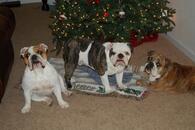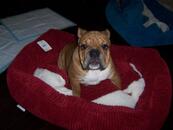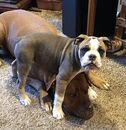kristendnae
New member
- Dec 23, 2014
- 6
- 0
- Country
- America
- Bulldog(s) Names
- Ellie
I just adopted a 4-year old, Deaf, female English bulldog. She is absolutely wonderful - she is already house trained, she understands quiet a few sign language signals, she adapted easily to sleeping on her own bed (rather than our bed) - our only issue is she is very aggressive with other dogs, of all types - young, old, male, female, large, small, etc.
We do not take her to dog parks, but when we walk her - if I see a dog coming our way, i will turn around or cross the street. Because she is deaf, it makes it a little easier since she isn't distracted by their barking.
She understands "no" when we shake our finger at her, however getting in front of her and getting her eyes/attention on me, when she is worked up over another dog is difficult. Any suggestions?
* She does not bark at them. She has zero issues with people. She did get too close the other day as we were coming down the stairs at our Condo and encountered another dog - the owner was holding him, but Ellie Jumped up twice trying to bite!
Any feedback is greatly appreciated!
Kristen
We do not take her to dog parks, but when we walk her - if I see a dog coming our way, i will turn around or cross the street. Because she is deaf, it makes it a little easier since she isn't distracted by their barking.
She understands "no" when we shake our finger at her, however getting in front of her and getting her eyes/attention on me, when she is worked up over another dog is difficult. Any suggestions?
* She does not bark at them. She has zero issues with people. She did get too close the other day as we were coming down the stairs at our Condo and encountered another dog - the owner was holding him, but Ellie Jumped up twice trying to bite!
Any feedback is greatly appreciated!
Kristen
 to EBN!!
to EBN!!



